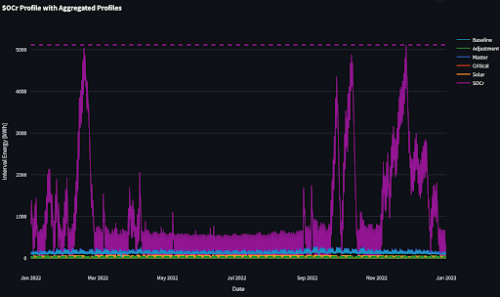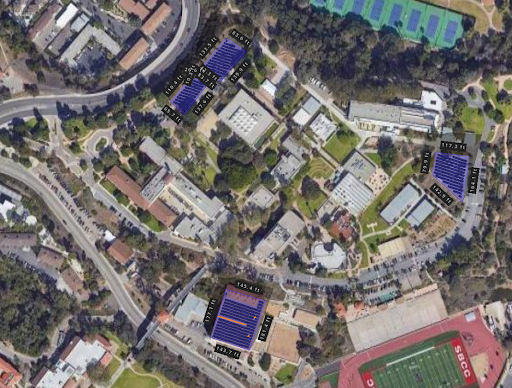
Solar Microgrid Methodology Curriculum
In partnership with Santa Barbara City College, the Clean Coalition curated its Solar Microgrid Methodology into a 6-week curriculum.
In the Fall 2023 semester, Santa Barbara City College’s (SBCC) Energy and Natural Resources course, led by Professor Bill Dinklage, partnered with the Clean Coalition to teach a six-week curriculum based on the Clean Coalition’s Solar Microgrid Methodology. This curriculum equipped 16 students with a comprehensive understanding of the fundamental principles, strategies, and tools employed in the development of a Solar Microgrid Feasibility Study. Students actively engaged in analyzing electricity data, modeling solar systems, sizing Battery Energy Storage Systems (BESS), conducting economic analyses, and presenting their findings in clear and concise formats. By the course’s conclusion, the students had gained a solid grasp of the Solar Microgrid Methodology and applied their knowledge to create a comprehensive Solar Microgrid Feasibility Study for SBCC’s East Campus. In this curriculum, students weren’t passive consumers of theory; they were architects of real-world Solar Microgrids, navigating the electrifying world of feasibility studies, system design, and economic analysis.
The Clean Coalition’s Solar Microgrid Methodology
The Clean Coalition’s Solar Microgrid Methodology is a comprehensive, five-step framework for analyzing the technical and economic feasibility of a Solar Microgrid. Each step serves as a critical building block, with outputs informing and enriching subsequent steps.
- Step 1: Load profiles
- Step 2: Resource scenarios
- Step 3: Site layouts
- Step 4: Economic analysis
- Step 5: Reporting and recommendations

Translating the Solar Microgrid Methodology into a six week curriculum
The Solar Microgrid Methodology’s five steps were translated into six weeks of available class time. With two classes per week, an hour and twenty minutes per class, and one class for a holiday, this calculates to just under 15 hours of class time. This carefully curated schedule balanced thorough learning with efficient knowledge transfer.
The Clean Coalition provided Professor Bill Dinklage with a robust support system to master the Solar Microgrid Methodology and confidently teach new generations in future curriculum classes. This included access to Clean Coalition team members during curriculum development and ongoing technical resources. However, the Clean Coalition recognizes the power of experiential learning and anticipates its support transitioning towards self-sufficiency. As the instructor gains firsthand experience with each curriculum cycle, the intensity of support will steadily taper. By the third teaching iteration, the goal is for the instructor to navigate the curriculum and methodology independently, with the Clean Coalition serving as a readily available consultative resource if needed. This fosters instructor autonomy and ensures the sustainability of the program into the future.
6-week Solar Microgrid Methodology Curriculum outline
This week-by-week outline provides a high-level overview of the curriculum, which will be elaborated upon throughout this blog post.
- Week 1: Electricity interval data and billing details
- Week 2: Solar design details and modeling
- Week 3: Value of Resilience 123 (VOR123) and sizing the BESS
- Week 4: Economic analysis
- Week 5: Project table creation and presentation preparations
- Week 6: Review & Presentations
Week 1: Analyzing Electricity Interval Data and Billing Details
Week 1 of the Curriculum introduced students to essential industry terminology, skills, and tools related to electricity usage, laying the foundation for subsequent analyses.
Topics covered:
- Distinguishing between power and energy, kilowatt (kW) and kilowatt hour (kWh).
- Understanding the common practice of recording electricity usage in 15-minute intervals.
- Interpreting and cleaning electricity data to establish a full calendar year’s Baseline Load Profile.
- Calculating the total annual load and peak demand from the Baseline Load Profile.
- Deciphering electric utility bills and meter rate schedules.
- Developing an Adjustments Load Profile based on the anticipated addition of electric vehicle (EV) charging stations.
- Combining the Baseline Load Profile and Adjustments Load Profile at every 15-minute interval to create the Master Load Profile.
Tools used:
- The Clean Coalition’s Solar Microgrid Analysis Processor (SMAP) Utility Data Cleaner: This tool simplifies the cleaning of electricity data downloaded from UtilityAPI, a secure, third party utility data service.
- The Clean Coalition’s EV charging profile creator: This tool assists in constructing an Adjustments Load Profile based on specified EV charging station quantities and usage patterns.
Week 2: Mastering Solar Modeling with HelioScope
Week 2 of the Curriculum delved into the practicalities of solar system design using HelioScope, a leading industry software from Aurora Solar. Following an onboarding session facilitated by Aurora Solar personnel, students tackled hands-on modeling of their own solar system for the East Campus meter.
Topics covered:
- Solar panel and inverter operation: Conversion of sunlight to direct current (DC) electricity and subsequent DC-to-AC (alternating current) transformation for grid integration.
- Impact of tilt, azimuth, spacing, and shading: Understanding how these factors influence a system’s energy output.
- Mounting system options: Differentiating between fixed tilt racking, flush mount, ground mount, and carport structures.
- Net Zero Energy (NZE) calculation: Determining the percentage of NZE achievable based on solar system design.
Equipped with the industry-standard HelioScope, students embarked on designing their own solar systems. This involved:
- Drawing the system layout: Accurately mapping the physical constraints of the East Campus site.
- Defining obstructions and shading: Placing virtual “keepouts” for existing structures and trees.
- Selecting optimal components: Choosing suitable solar panels and inverters for efficient energy generation.
- Leveraging Light Detection and Ranging (LiDAR) data: Utilizing LiDAR technology to map building and tree heights for accurate shading analysis.
After finalizing their designs, students downloaded the corresponding solar generation data, setting the stage for BESS sizing and economic analysis in Weeks 3 & 4.

Week 3: Value of Resilience (VOR) 123 and BESS Sizing
Building upon data from previous weeks, Week 3 of the Solar Microgrid Methodology curriculum immersed students in the Clean Coalition’s VOR123 methodology and how to use the Solar Microgrid Analysis Processor (SMAP) to size the BESS. An initial onboarding session by Clean Coalition personnel equipped students with the necessary skills for BESS sizing calculations.
Topics covered:
- Clean Coalition’s VOR123: This methodology tiers electrical loads into three categories — critical, priority, and discretionary loads — across all facility types. The level of resilience anticipated from a Solar Microgrid at a facility where the Tier 1 load is 10%, Tier 2 load is 15% and Tier 3 load is 75% and where enough solar can be included onsite to net-zero the site’s annual electricity consumption. The average anticipated resilience, in terms of percentage of time online, is as follows:
- Tier 1: 100%
- Tier 2: 80% (at least)
- Tier 3: 25% (at least)
Tools used:
- The Clean Coalition’s Solar Microgrid Analysis Processor (SMAP) Aggregated Profile Spreadsheet (APS) Builder: This tool takes user-defined inputs (Baseline Load Profile, Adjustments Load Profile, Critical Load Profile or percentage of critical load, and solar generation profile) to generate the Master Load Profile and an APS. The APS comprises:
- Baseline Load Profile
- Adjustments Load Profile
- Master Load Profile
- Critical Load Profile
- The Clean Coalition’s SMAP State of Charge reserved for resilience (SOCr) calculator: When fed the APS, this calculator sizes a BESS to indefinitely cover (with the help of the solar system) the user-specified critical load percentage or profile.

Week 4: Solar Microgrid Financial Analysis
Week 4 of the Solar Microgrid Methodology curriculum immersed students in financial modeling using Energy Toolbase, a gold standard in the industry. Students explored critical financial metrics, delving into the cost-savings potential of their proposed East Campus Solar Microgrid.
Topics covered:
- Capital and operational costs for installing solar panels and BESS
- Incentives for Solar Microgrid components
- Discount rates and electricity escalation rates
- Demand charge management and energy arbitrage strategies
- Cash purchase versus power purchase agreement (PPA) options
- Electrical bill savings and 25 year cash flow projections
Leveraging Energy Toolbase, students meticulously conducted a financial analysis of their Solar Microgrid designs. This comprehensive process involved:
- Data Integration: Importing the Master Load Profile and aligning it with the specific rate schedule of the East Campus meter.
- Solar Generation: Entering their HelioScope solar generation profile and defining a $/W value.
- BESS Configuration: Selecting a standard BESS option and specifying its operational strategy, encompassing demand charge management, energy arbitrage, or both. Additionally, they set a $/kWh value for the BESS.
- Cost Accounting: Establishing Operations and Maintenance (O&M) expenses and costs associated with system component replacements.
- Rate Analysis: Comparing the available solar- and BESS-friendly rate schedules and performing rate switches to understand their economic impact.
- Financial Scenarios: Selecting a transaction type, such as cash purchase or PPA, to explore different financing options.
Energy Toolbase then generated insightful reports, including projected electric bill savings, cumulative cash flows, and other key financial metrics, for each student’s design over a 25-year period.

Week 5: Project Table Creation and Presentation Preparations
Week 5 of the Solar Microgrid Methodology curriculum consisted of students compiling their hard work into project tables and presentations. These tables summarized their actions and key findings from the previous four weeks, including analysis steps, system sizing, resilience benefits, and economic results. Presentations utilized these tables alongside graphical outputs from the tools they used to provide a comprehensive picture of the proposed East Campus Solar Microgrid designs.
Students were guided on formatting their Solar Microgrid Feasibility Study presentations using Google Slides to:
- Start by presenting compelling key economic results and details on system sizing.
- Provide a concise overview of the analysis steps taken.
- Go in-depth into each major step of the process.
- Conclude with clear recommendations and next steps.
Week 6: Review & Presentations
The culminating week of the Solar Microgrid Methodology curriculum saw student groups polishing their presentations and confidently showcasing their completed Solar Microgrid Feasibility Studies to a distinguished audience of SBCC, Santa Barbara Foundation, and Clean Coalition personnel. Key members in attendance or who were involved in the curriculum included:
- Erika Endrijonas, SBCC Superintendent/President
- Jens Uwe-Kuhn, SBCC Dean of Sciences
- Erik Fricke, SBCC Director of Campus Safety and Emergency Response
- Maria Villagómez, SBCC Assistant Superintendent/VP of Academic Affairs
- Dr. Bill Dinklage, SBCC Professor Dept. of Earth and Planetary Sciences
- Brian Morales, SBCC Director of Campus Safety and Emergency Response
- Mark Broomfield, SBCC Facilities Supervisor
- Craig Lewis, Clean Coalition Executive Director
- Gregory Young, Clean Coalition Program Manager
Reactions and feedback
Overall, the Solar Microgrid Methodology curriculum received strong feedback from SBCC faculty and students. Below are some of the quotes we received from staff and students of SBCC.
“I really appreciated the opportunity to see Professor Bill Dinklage’s Fall ENVS 116 students present the potential applications of microgrids and microgrid technology on the SBCC campus. Our campus needs to be more “green” in its practices, especially as we begin to explore programs to support the “blue” economy here in Santa Barbara.” – Erika Endrijonas, Superintendent/President of SBCC
“Working with the Clean Coalition to guide my Energy and Natural Resources class through their solar microgrid methodology was a fabulous professional development opportunity for me and gave the students a very practical and eye-opening taste of what it is like to apply the concepts of solar energy and energy storage they learned in class to the real world. The Clean Coalition was there for me 100% to make the project a success.” – Bill Dinklage, Professor Dept. of Earth and Planetary Sciences and Teacher of the Solar Microgrid Methodology Curriculum
“The Solar Microgrid curriculum was a truly eye-opening process. Learning about the intricacies of developing a solar microgrid while using the professional software that we had access to through the Clean Coalition in the real-world setting of our own campus made for an incredibly hands-on experience. I really enjoyed this curriculum, and both the technical skills we learned and a fascination with solar microgrid technology are things that will stay with me for a long time.” – Nick Parker, Student of SBCC Solar Microgrid Methodology Curriculum
In conclusion, this experience shattered the boundaries of traditional classroom learning, offering the students an unparalleled level of practical immersion in the world of Solar Microgrid development. Unlike textbook simulations and case studies, this course plunged them headfirst into real-world data analysis, system modeling, and feasibility assessments. Partnering with the Clean Coalition, an established industry leader, allowed them to leverage cutting-edge tools and expert insights that are typically inaccessible in academic settings. This unique combination of practical challenges and professional guidance transformed the classroom into a vibrant launchpad for their careers, equipping them with not just theoretical knowledge, but the tangible skills and confidence to thrive in the burgeoning field of clean energy. For these students, this wasn’t just a six-week course; it was a springboard into a future powered by their own hands-on expertise.

